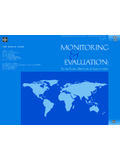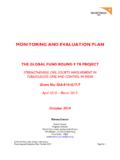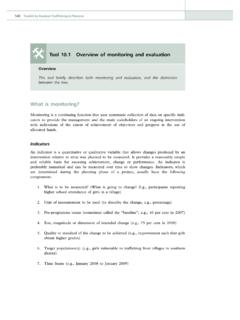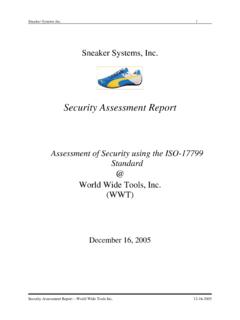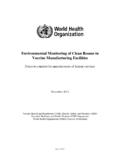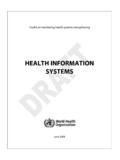Transcription of A Manual on Monitoring and Evaluation for …
1 A Manual on Monitoring and Evaluation for Alternative Development Projects Contents List of Contents Page Foreword 1 Preface 3 Introductory Session 5 Module 1 : Conceptual Framework for 9 Alternative Development Module 2 : Designing and Implementing 29 the Alternative Development Project Monitoring Module 3 : Designing and Implementing Alternative 41 Development Project Evaluation Module 4 : People s Participation: How do we go about it? 57 Module 5 : Data Analysis, Interpretation and Presentation 73 Instruments Module 6 : Field Testing for Monitoring & Evaluation 89 Tools and Methods: Gaining Practical Experiences Appendix I : Programme of Training 117 Appendix II : List of Participants 121 1 Foreword It s about Leadership Alternative development is about development, for sure.
2 But it is first about Alternative . Alternative means change. It is impossible to hope that people involved in illicit crop production willingly engage in an alternative venture, to be supported by their ignorance on market conditions, by their lack of food security, public health and often widespread illiteracy. That is why leadership plays a fundamental role in providing a cornerstone for rural commitment to alternative livelihoods. More often than not, leadership is about a strong group of village leaders, who wish to guide their people in pilot alternative income generating activities and have the technical know how to be credible and effective. And there training becomes the real engine of successful alternative development ventures.
3 The Regional Centre for East Asia and the Pacific is glad to share our know-how and good practices in this field. Sandro Calvani UNODC Representative Regional Centre for East Asia and the Pacific 3 Preface Monitoring and Evaluation can be effective tools to enhance the quality of project planning and management. Monitoring helps project managers and staff to understand whether the projects are progressing on schedule and to ensure that project inputs, activities, outputs and external factors are proceeding as planned. Evaluation can be a tool to help planners and managers assess to what extent the projects have achieved the objectives set forth in the project documents.
4 This Manual intends to provide some basic information and practical guidelines on project Monitoring and Evaluation in order to enhance better understanding on project Monitoring and Evaluation . All modules in this Manual were used for the regional training on Monitoring and Evaluation for Alternative Development Projects and have been revised and simplified for distribution to interested project planners, managers and field staff. It is hoped that the Manual will serve as their reference to acquire better understanding on project Monitoring and Evaluation and to obtain some practical guideline on the design and implementation of project Monitoring and Evaluation .
5 We also hope that the Manual will enhance the capacity of the planners and managers to understand both qualitative and quantitative approaches to project Evaluation and to be able to discuss with project evaluators on the needs and requirements for their project Evaluation and to fully comprehend the results of the Evaluation from both qualitative and quantitative methods. I would like to thank the team of resource persons from Chiang Mai University for their contributions to the regional training and the development of this Manual . Sanong Chinnanon Coordinator for Alternative Development Cooperation Contents List of Contents Page Foreword 1 Preface 3 Introductory Session 5 Module 1 : Conceptual Framework for 9 Alternative Development Module 2 : Designing and Implementing 29 the Alternative Development Project Monitoring Module 3 : Designing and Implementing Alternative 41 Development Project Evaluation Module 4 : People s Participation: How do we go about it?
6 57 Module 5 : Data Analysis, Interpretation and Presentation 73 Instruments Module 6 : Field Testing for Monitoring & Evaluation 89 Tools and Methods: Gaining Practical Experiences Appendix I : Programme of Training 117 Appendix II : List of Participants 121 5 INTRODUCTORY SESSION* 1. INTRODUCTION Golden Triangle continues to be the main source of global opium production. Its potential capacity for the world supply is estimated at 1,237 tons of raw opium, equivalent to 76% of total world production. This also means approximately that a total of 123,000 ha of critical mountain land is required for opium cultivation in Southeast Asia. The current efforts with Alternative Development (AD) strategy have been implemented throughout the region with national government and international community.
7 In support to the on-going AD Projects, the United Nations Office on Drugs and Crime (UNODC) Regional Centre in cooperation with the Australian Government has supported sub-regional activity on Alternative Development Cooperation in East Asia (C96) since the year 2000. As part of the present work plan, a regional training on Project Monitoring and Evaluation (M & E) has been readily endorsed by the Project Coordination Committee to strengthen national capacity with support to AD personnel and Project staff. The need for Project M & E training was expressed at the annual meeting of the Project Coordination Committee (PCC) for Alternative Development Cooperation in East Asia in Luang Prabang on 11 March 2002.
8 In response to the need, Regional Centre for East Asia and the Pacific, led by Dr. Sanong Chinnanon, has initiated the training project document for working with host institutes in Thailand. The International Centre (IC) of Chiang Mai University has agreed to serve as host institute and academic staffs from the University has formed up an interdisciplinary team to assist the training. The training workshop has been designed for implementation between 11-16 November 2002, in Chiang Mai province of northern Thailand. 2. PROJECT OBJECTIVES The objective of the Regional Training Workshop is to provide some basic knowledge and gain a better understanding as well as practical skills for project managers and staff from Alternative Development (AD) Projects.
9 Participants have been recruited from the member countries of the Southeast Asia Sub-region where Alternative Development Strategy is being utilized to prevent and eliminate the cultivation of illicit drug crops. This Training Workshop is expected to enable * Luechai Chulasai, International Center (IC), Chiangmai University, Chiang Mai 6 participants to plan and implement Monitoring and Evaluation tasks as part of project management and implementation. 3. WORKSHOP STRUCTURE, DESIGN AND TRAINING PROCESS This Regional Training Workshop is organized into 5 training modules: Module 1: Overview and Conceptual Framework for Alternative Development Module 2: Design and Implementation of Alternative Development Project Monitoring Module 3: Design and Implementation of Alternative Development Project Evaluation Module 4: People s Participation in Alternative Development Project Monitoring and Evaluation Module 5: Data Analysis, Interpretation and Presentation Module 6: Field Testing for Monitoring and Evaluation Tools and Methods.
10 Gaining Practical Experiences In short, the Training Workshop consists of 3 major components to include conceptual framework of alternative development, the basic principle of project Monitoring and Evaluation with specific reference to development and drug control projects and the design and implementation of Monitoring and Evaluation . The overall training process may be illustrated in a flow diagram as shown in Figure 1. 7 Conceptual Framework on Alternative Development (AD) Increase Understanding in Monitoring and Evaluation For AD Projects Increase Capacity for the Monitoring and Evaluation for AD Projects Tools and Methods for Field Test: Data collection Monitoring and Evaluation and data analysis Group Presentation, Report Write up And Communicating Results FIGURE 1.










